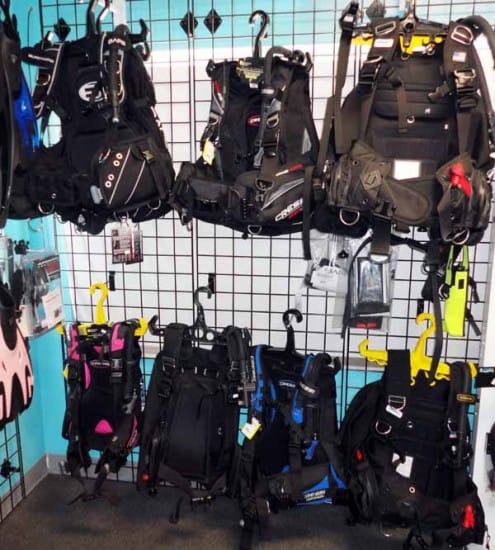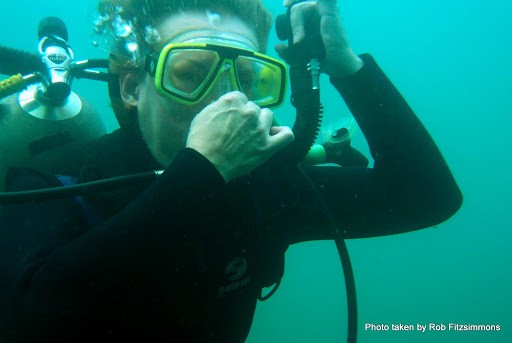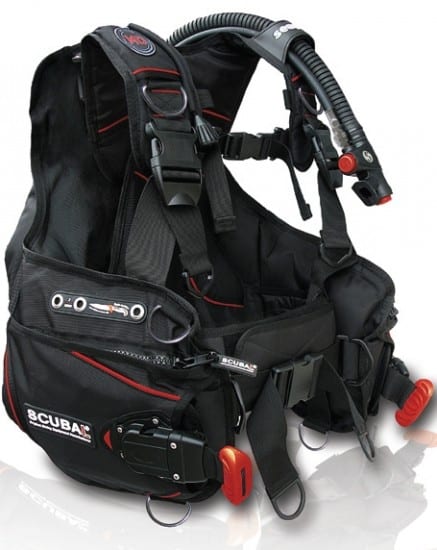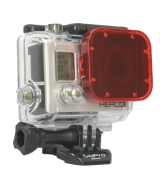I’m pretty sure we all have experienced touching the bottom part of the reef, right? Some divers even push themselves up to stay afloat while some end up hurting themselves by crashing on the reef bottom because of being negatively buoyant.
Controlling and being neutrally buoyant using the Buoyancy Control Device (BCD) is a very important skill a diver should have. Being neutrally buoyant does not only prevent you from crashing down the bottom but it also lessens incidents of damaging the corals and disturbing the bottom dwelling animals. More often than not, majority of new divers have problems when it comes to controlling their buoyancy.

BCDs of various styles and designs are available on diveshops/centers to cater to the different needs and preferences of divers.
Photo credit: Dayo Scuba at http://www.scubadiver.cc/
Ever wondered how your BCD is made? Check out this video to find out how!
http://www.youtube.com/watch?v=4UFF6ej_oqM
The BCD is one of the most important gears divers use in Scuba Diving, it’s your life support system underwater. It is commonly referred to as diving vest, dive jacket and buoyancy compensating device. Apparently, this device is named such as it is used to control or adjust a diver’s buoyancy. The BCD can be inflated or deflated. With just a touch of a button, divers can choose to hover, ascend and descend underwater. Another purpose of the BCD is that it holds the SCUBA tank and keep it safely attached to the diver’s body.

A diver equalizing while pressing the deflator botton to descend underwater.
Photo credit: Rob Fitzsimmons
Now, can you imagine yourself diving without a BCD? Well, not unless you can adjust your buoyancy underwater by yourself or would want to carry your tank all throughout the dive then you just might don’t need one, right? 
Styles of BCD
Over the years, various BCD styles and designs were released. However, there are two primary styles that dominates diveshops in the planet nowadays, namely the BCD Jacket and the Harness or Wings.

The jacket style BCD inflates both of its front and back, which is suitable for new divers.
Photo credit: http://www.aquateccanada.ca/
This BCD jacket is undeniably the most popular style of BCD most specifically used in recreational diving. A typical BCD jacket inflates both its front and back air bladders.
The BCD wings inflate only on its the back and are more commonly used in technical diving:

Because it only inflate on its back, the BCD Wings is suitable for experienced divers since it has the tendency to turn the diver face down.
Photo credit: http://www.diverswarehouse.co.uk/
Basic Parts of a BCD
- Air bladders – Where air goes in when the BCD is inflated.
- Adjustable band – Located at the back of the BCD, this straps and holds the SCUBA tank in place. It allows divers to conveniently change their tanks whenever needed. All scuba divers learn how to adjust the band during the open water course.
- Inflator – This allows the diver to inflate the BCD by pressing the power buttons.
- Deflator – This button allows the diver to deflate or release air from the air bladders.
- Pockets – The pockets are located on each side of the jacket. It allows divers to carry accessories and even weights.Some BCDs have integrated weights system thus, eradicating the need to wear weightbelts.
- Dump/Quick Valves – Valves that let you expel air without using the deflator.
How to Choose your BCD
- Choose based on your gender. Men’s BCD have longer torso while a woman’s BCD have shorter ones. Women’s BCD are specially designed and made that way since women have shorter backs than men. Some women’s BCD don’t have chest straps as well to avoid compressing the bust. So, for women divers, they better settle for a woman’s BCD!
- Second, choose which kind of diving you do. If you are a recreational diver then the jacket style is good for you. Plus, using the jacket style BCDs can make divers more comfortable on the surface since it inflates all around. The wings on the other can make divers (especially new divers) to be less comfortable on the surface because the tendency to push the diver forward.
- Once you have done the first 2 things then it’s time to try and fit the BCD!
- It’s actually not necessary to wear a dive suit when trying the BCD. What’s important is that there is enough space that allows movement and that you can adjust the BCD to your preferred fit.
- Although wearing a dive suit is not required, it is best however to bring with you your regulator to ensure compatibility of your hoses and accessories with the BCD.
Watch this video to help you more choose the best BCD for you!
With a lot of BCDs on the market to choose from, some divers tend to make the wrong decision and mistake by buying BCDs based on its look. A diver should always remember that safety is most important and quality is the key rather than the looks. Happy diving everyone! 
 Destinations
Destinations









I couldn’t agree more with you and the guy on the video. Fit and comfort should be the main priority in choosing a BCD. It should fit your body well-enough:not too loose and not too tight. A BCD could make or break your buoyancy so choose wisely!
Fit and comfort should be the main priority in choosing a BCD. It should fit your body well-enough:not too loose and not too tight. A BCD could make or break your buoyancy so choose wisely!